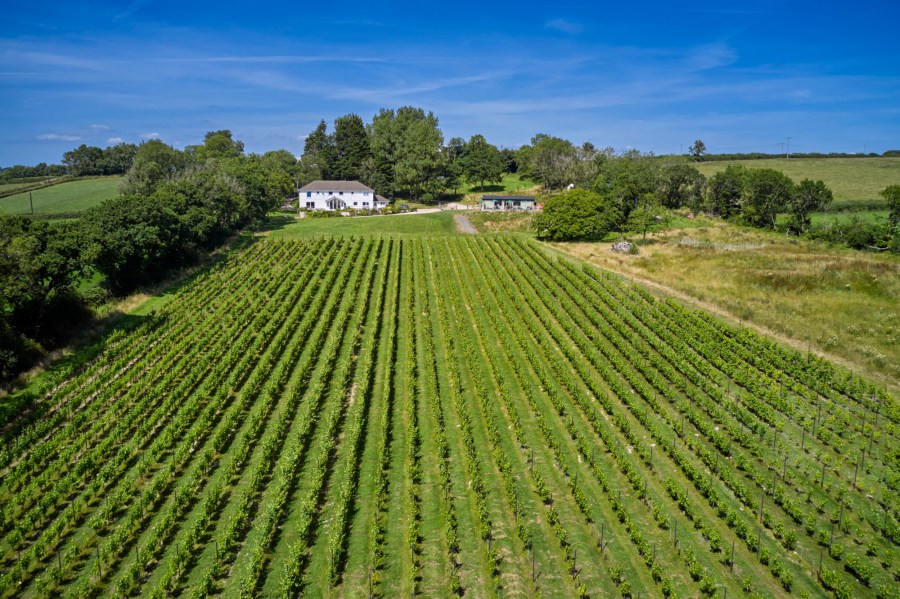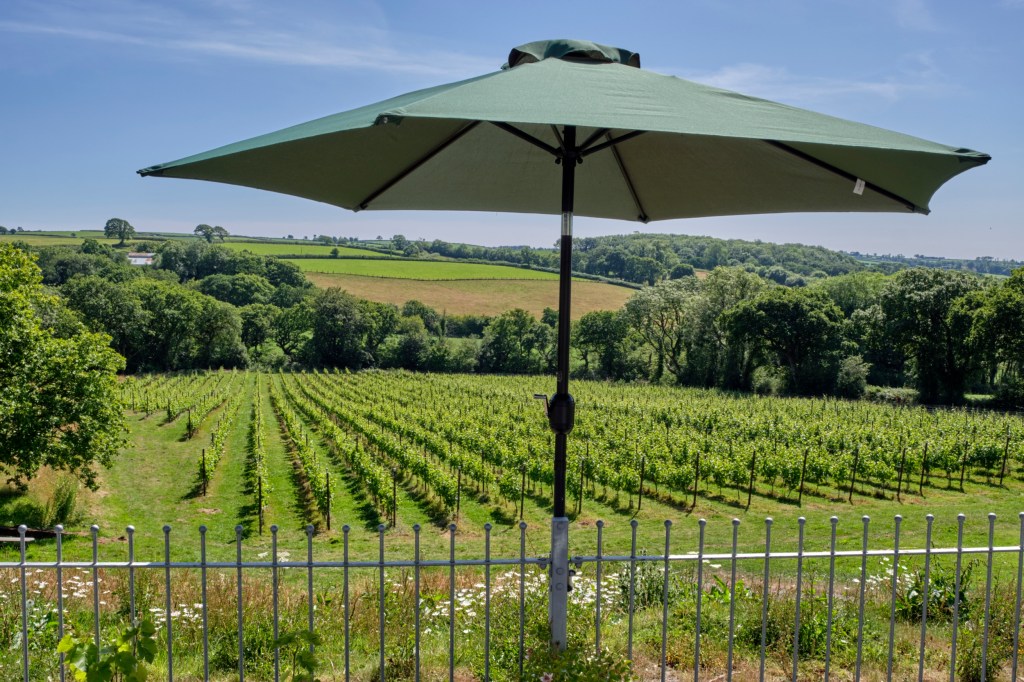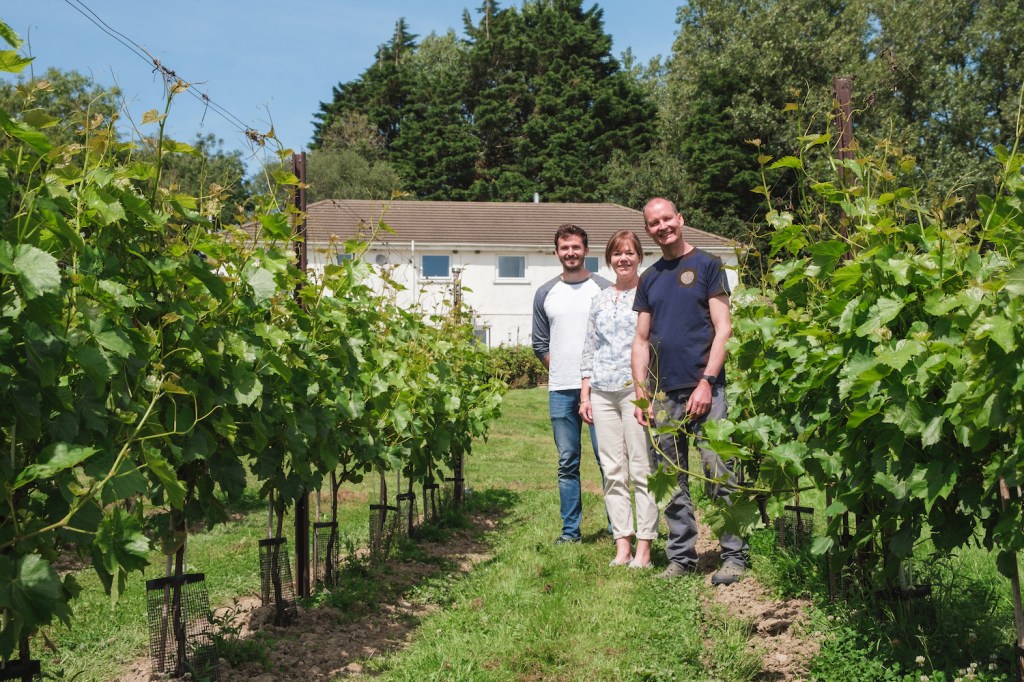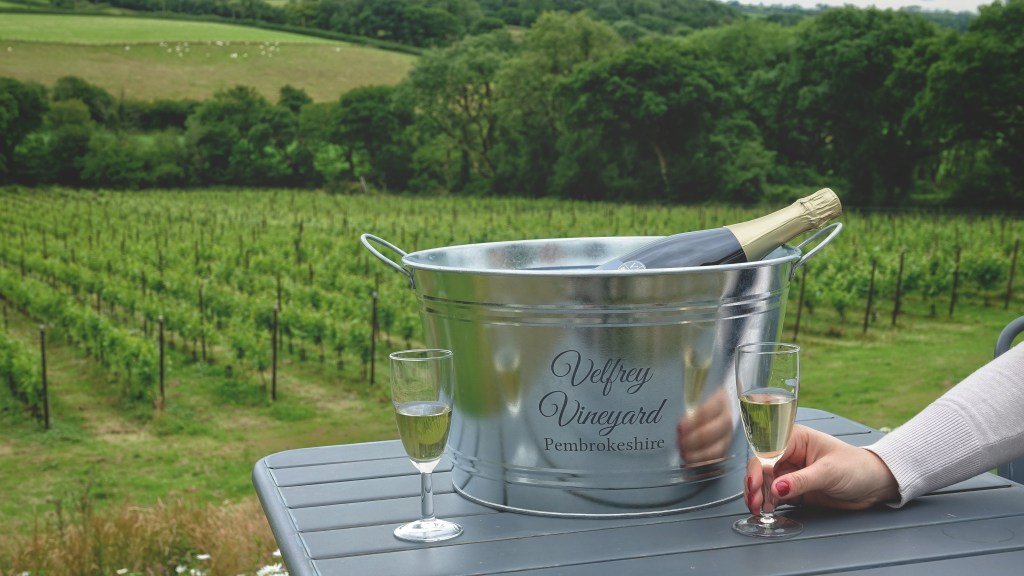Andy and Fiona Mounsey were looking, first and foremost, for somewhere close to a coastline to live and maybe have a few sheep. A chance visit to a nearby vineyard in neighbouring Carmarthenshire, changed all that. Christian Davis visited Velfrey in Wales.
From publisher to sheep farmer to wine producer, Andy Mounsey and his wife Fiona, have got to producing Welsh wine in a circuitous way, to say the least.
Established in 2016, Velfrey Vineyard occupies a gentle south facing slope of the Lampeter Vale in the south Pembrokeshire countryside between Narberth and Whitland. Planted in 2017, last year the vineyard produced seven tonnes of grapes, approximately 6,500 bottles of Seyval Blanc, Pinot Noir and Solaris.
“I am not a farmer,” said Andy. “I have a degree in agriculture from Edinburgh university. I graduated in 1986 and in those days a Scottish agriculture course did not have any viticulture,” he quips.
The couple have a publishing business. They publish a bi-monthly agricultural magazine, called Feed Compounder, for the animal feed industry. Andy is the editor. “Vineyard and publishing work well together,” he said. “Publishing is essentially an indoor job you can do when it is raining – sitting at a desk, page layouts, editing, chasing copy, finding articles. The vineyard is obviously, outdoors. They complement each other. Our son, Ryan works on both as well.”
So how did they come to set up in Wales? Fiona is from Ayr in south west Scotland. Her family is from Dumfries & Galloway. According to Andy, the growing conditions there are similar to Pembrokeshire. “They have palm trees,” he exclaimed. Fiona hankered to live near to the sea so “the motivation was to find somewhere near to the coast. When our younger son, Craig, went to study medicine, there was a natural break. We felt, ‘if we are going to move, now is a good time’. The Peak District is as far from the coast as it could be.”
They looked at different places such as Northumberland, the north Yorkshire coast, Lancashire, Dorset. Then research took them to Pembrokeshire.
“We saw beautiful countryside, fabulous beaches, friendly people – unbelievably friendly. We found the local people, instead of being resentful of people coming in, are proud of that. We find locals so, so, friendly. Then lots, who have moved here, have the get-up-and-go about them.
“We fell in love with Pembrokeshire, in the course of looking for places with land for keeping sheep. Having run a magazine for decades, the idea was to buy somewhere with land and keep 20 or so, sheep – buy feed from the producers who we have been writing about. A certain circularity.”
So, the couple moved to Wales from the Peak District in 2014.
“We did that for two years. Buy sheep in the spring, fatten them and sell in the back end of the year. That is the theory. The trouble is you need all the paraphernalia. Whether for 20, or for 200 – troughs, dosing guns etc. We found they have a tendency to get lost, trying to find various ways of doing themselves harm. We then found they weren’t worth anymore than what you had paid for in the first place.”
The couple visited Jabajak, a small vineyard and restaurant with rooms in nearby Llanboidy. “We happened to be there for their first white wine,” said Andy. “We felt obliged to order a bottle; it was fabulous, 35 quid a bottle. Very, very impressed. At that stage, our two sons said: ‘Ever thought about having a vineyard?’ Well, we thought: ‘Once you plant vines, they won’t run away. Why on earth don’t we consider that?’ What a crazy idea.
“We spoke to Amanda, the owner at Jabajak. We thought we would be a local rival to them but Amanda could not have been more encouraging. ‘You’ve got to do it’, she said.”
That was the trigger for the Andy and Fiona to start seriously looking at it. Andy came across the name of Stephen Skelton. He bought Skelton’s book.
“The first chapter asked: ‘Why on earth are you doing this? You won’t make any money and it will take all your time.’ He was trying to put off the faint-hearted. The first proper chapter is on site selection, coming from the fact that you may have a dream but do you have a site?
“As we all know the ideal latitudes for growing grapes is between the latitudes: 30-50. “We’re quite far north at 53.5. That’s a big percentage north. But with climate change and hybrids, that is a more viable principle. In Great Britain we do not want anything that lowers the temperature when grapes are ripening: not too close to the sea – Velfrey is 8km from the coast. Also, not to high above sea level – no more 100m.
Velfrey is 65m above sea level and there is a 10m drop from the top of the vineyard to the bottom. Facing due south, on a slope, and with a copse of trees in the south west corner, shielding the vines from the prevailing winds, Andy described it as the “Goldilocks zone”.
“It was every single box ticked,” said Andy. “We had no intention of picking a vineyard when we came here. It is why we have been called ‘The Accidental Vineyard’.”
The Mounseys paid for a day of Stephen Skelton’s time to look at the site and in terms of planning. They still were not committed to the project. “I was asking myself: ‘Am I seeing things through rose-tinted glasses?’ It seemed as close to ideal as possible.”
Stephen duly arrived and spent the day at Velfrey. He is not a man to dabble with. Straight talking, he doesn’t suffer fools gladly. If he thought the site unsuitable, you would soon know about it.
“I thought he would be a bit sniffy about a vineyard in West Wales, with no tradition of vineyards, to speak of. He spent the day here going through all aspects of the vineyard. At the end of it, he said: ‘This is a cracking site for a vineyard.’
“So, if Stephen Skelton thinks it is a ‘cracking site for a vineyard’, I had run out of excuses as to why we shouldn’t do it. That was the trigger, over the line and go ahead and do it.
Andy quoted a statistic: “75% of vineyards in the UK are said not to be on optimal sites. If you wish to have a vineyard and have the land, there is the temptation that it will be fine.”
“We always say: ‘We didn’t find the vineyard. It found us’. It was pure luck. We chose the house with the knowledge that the garden was south-facing, thinking that would be an advantage for growing flowers. But really the aspect of the field is pure luck. The house is right next to the vineyard. So, to work in the vineyard, you can arrive very quickly. That is fortunate. The proof of the pudding is in the drinking.”
The Mounsey’s 30-year-old son, Ryan, helps in the vineyard. He has a degree in Ancient History and Archaeology – “A qualified hole digger!” Andy quipped. Ryan’s partner, Sophie, helps, primarily with vineyard visitors.
“I tend to focus on the vineyard, looking after the vines, anything to do with tractors and machinery. Fiona has a degree in Pharmacology and before joining the publishing company was selling pharmaceuticals to doctors. Selling to doctors has been good training. Fiona sells advertising space in the magazines but she also gets out into the vineyard.
The Mounseys have three wines, two sparkling and a Solaris still made by Halfpenny Green in Staffordshire.
Last year Andy also used Mountain People Wine in Monmouthshire, a small new venture that produces low-intervention wines from its own leased vineyards and under contract for other growers.
It is making a still wine from some of Velfrey’s Seyval Blanc, which was left to ripen for “as long as we dared,” said Andy. Five rows with all the leaves removed were picked on 7 November to get maximum exposure.
The whole bunches were sealed in stainless steel tanks under CO2, called ‘semi carbonic maceration’. Left under their own weight, the juice was gently released. Later the contents were then gently pressed. Approximately half went into some old Bordeaux barrels while the other half went into stainless steel tanks. There was then a long slow fermentation using natural yeast and lees stirring. The hope is any flavour from the yeast will be imbued into the wine and juice and the 50:50 blend will provide hints of oak and texture.
On blending and racking, there is no fining or filtering, so no flavour compounds are stripped out.
It is still early days but Andy has tasted it. “Very clean, delicate apple blossom, hints of oak. We’re really looking to the end result. It is 100% Seyval Blanc, 100% grown in Wales, 100% made in Wales with natural fermentation. Seyval Blanc grapes are naturally low in sugar. So also, it will be relatively low in alcohol. That ticks another box.”
‘Naturiol’, the welsh word for natural, is expected to be released in September.
The Velfrey NV from Halfpenny Green is, traditional method sparkling brut, comprising Seyval Blanc, Pinot Noir and 10% Chardonnay, which comes from Halfpenny Green. It has 18 months lees ageing.
The third Velfrey wine is: Cuvee Reserve 2019, which is Seyval Blanc (66%) and Pinot Noir.
Andy Mounsey is a huge fan of Solaris (see accompanying feature on Danish vineyard Dyrehøj). “It is going down an absolute storm,” he said.
“I think it is a really good grape for our conditions. The yields are very good; it does not need a lot of spraying to keep it disease-free and most importantly makes a beautiful wine.
“Disease resistant, yielding reliably, makes a delicious wine, well that’s a no-brainer as far as I am concerned.
“I think it could be the variety of Wales,” so said the chair of the Welsh Vineyards Association. Praise indeed.
“There are lots of good examples. The variety seems to suit our conditions here and makes a fabulous wine.
“We had a lot of consideration as to what went in. I think we have it pretty much spot on for our choices for white. The Seyval Blanc is such a good grape for us. It makes fantastically good sparkling wine.
“When I do tours and then offer tastings. Looking at their faces: ‘Oh my goodness, that is good’.”
The Grove Hotel, voted best hotel in Wales by The Sunday Times, is a customer. The Greek sommelier from the £200+ a night, near Narbeth, came to taste.
“He just said: ‘Yeah, oh yeah, I’ll have 24 bottles of that one and 24 bottles of that one and they have now put the Velfrey on the wine flight for the chef’s 10-course tasting menu. This is great for us because guests from America and around the world, staying at The Grove, come and visit. There is now ‘Velfrey Afternoon Tea’ – £48 for afternoon tea with one glass of Velfrey. We sell a bottle a day from there.
“Because our production is so limited from our first couple of harvests, we just sell in a few places Narbeth, Whitland, St David’s, Tenby, a wine merchant in Swansea. We are not trying to expand trade sales. We’ve got what we have got. We don’t want people coming to the vineyard and find that we have to say: ‘Sorry, we have no wine left’. Once the seven tonnes from 2021 is ready to sell we will be able to supply more trade customers.”
As to challenges, Andy said: “Learning. We had no experience whatsoever.”
“We do not know what the capacity of Velfrey will be. We need a few more years of harvesting to establish what is ‘bang average’. Obviously, each year as vines get older, we will get more grapes. . Was last vintage exceptional, or average? We will find out after a few vintages,” concludes Andy.
Still, boxes ticked…
Welsh cluster
Andy Mounsey is chair of the Welsh Vineyards Association, which is essentially the Welsh region of WineGB. He was elected last April. The association comprise approximately 24 members, with around 40 hectares of vines planted. There are 32 vineyards overall in Wales.
“We have a ‘cluster approach’. The theory is a bit like Silicon Valley. If you can cluster industry, academia and government ¬¬it is like the three legs of a stool, mutually self supporting and brought together to help each other. We cross over expertise such as with the spirits guys.
“There is a Food & Drink Wales cluster and within that a Drinks Cluster: wine, cider, beer, tea, coffee, soft drinks – everything. Then within that there is the Wine Special Interest Group (WSIG).”
The Drinks Cluster and WSIG is managed by a specialist management company, Levercliff. The Welsh government does not have the necessary expertise and do not want to be involved day-to-day so, it contract out the management.
“They have resources and access to the Welsh government. That allows us to punch above our weight,” said Andy Mounsey.
Recently Velfrey had a booth at the National Geographic Traveller magazine show. Entry tickets were provided and the stand was bespoke, all organised by Food and Drink Wales.
“Next to us were a pickle company, spirits producer and Welsh crackers – all protected food names from Wales under PGI (Protected Geographic Indication), said Andy.
“We benefit from subsidies from the Welsh government. It wants to promote Welsh food and drink, and as destination tourism. Other shows attended include: the Royal Welsh Show and the Swansea International Wine Fair.
By the way, how was Welsh Wine Week? “Very good,” replies Andy. “We are very lucky. The Welsh government helps a lot.”
- 1242072
- Andy and Fiona Mounsey with the help of son Ryan
- “I think Solaris could be the variety of Wales”
Vineyard fact sheet
Vineyard:
One hectare – 4,000 vines
Grape varieties:
Pinot Noir: The classic sparkling varietal, Pinot Noir’s thin skins and low tannin levels make it perfect for cooler climate conditions. Produces high quality, complex wines.
Seyval Blanc: A white variety ideally suited to cooler climate vineyards. Capable of producing world class, award winning sparkling wines.
Solaris: Produces wonderful perfumed and subtly fruity wines. The low acidity and high sugars of this early ripening white grape translate into a gorgeous single varietal a white wine.
The first non vintage traditional method quality sparkling white wine is available to order now. Our first Vintage wine was released in June along and our first Solaris still white wine in May. In September we will launching our 2021 skin contact Seyval Blanc natural wine.
Diseases experienced:
No mildew. Sour rot in 2020. A bit of botrytis last year on Seyval.
Soils:
Sandy clay loam
Aspect:
Due South
Pests:
None.
Treatments:
Minimal intervention. Reducing use of bought in sprays to as low as we can while keeping disease under control. Using willow and nettle tisanes, comfrey, seaweed, foliar feeds etc plus sprays from the organic programme in the Green Book.
Trellising:
Powder coated galvanised 2.7m metal posts every 6m with three pairs of foliage wires and a fruiting wire at 700mm from the ground.
Green harvest:
No
Canopy management:
Battery powered hedge trimmer. Leaf stripping in the fruiting zone. Removal of laterals. Dropping and later raising bottom pair of wires then tucking in.
Harvesting:
By hand.
Timings…
Harvest early October (Solaris). Late October (Seyval and Pinot Noir for sparkling). Early November (Seyval for still)
Trends
Reducing chemical use. Introducing wider range of wines. Increased yields.
What’s new?
Cuvée Reserve









